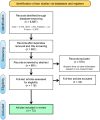A panoramic view of personalization based on individual differences in persuasive and behavior change interventions
- PMID: 37841233
- PMCID: PMC10570753
- DOI: 10.3389/frai.2023.1125191
A panoramic view of personalization based on individual differences in persuasive and behavior change interventions
Abstract
Persuasive technologies are designed to change human behavior or attitude using various persuasive strategies. Recent years have witnessed increasing evidence of the need to personalize and adapt persuasive interventions to various users and contextual factors because a persuasive strategy that works for one individual may rather demotivate others. As a result, several research studies have been conducted to investigate how to effectively personalize persuasive technologies. As research in this direction is gaining increasing attention, it becomes essential to conduct a systematic review to provide an overview of the current trends, challenges, approaches used for developing personalized persuasive technologies, and opportunities for future research in the area. To fill this need, we investigate approaches to personalize persuasive interventions by understanding user-related factors considered when personalizing persuasive technologies. Particularly, we conducted a systematic review of 72 research published in the last ten years in personalized and adaptive persuasive systems. The reviewed papers were evaluated based on different aspects, including metadata (e.g., year of publication and venue), technology, personalization dimension, personalization approaches, target outcome, individual differences, theories and scales, and evaluation approaches. Our results show (1) increased attention toward personalizing persuasive interventions, (2) personality trait is the most popular dimension of individual differences considered by existing research when tailoring their persuasive and behavior change systems, (3) students are among the most commonly targeted audience, and (4) education, health, and physical activity are the most considered domains in the surveyed papers. Based on our results, the paper provides insights and prospective future research directions.
Keywords: adaptation; individual differences; personalization; persuasive technology; user modeling.
Copyright © 2023 Alslaity, Chan and Orji.
Conflict of interest statement
The authors declare that the research was conducted in the absence of any commercial or financial relationships that could be construed as a potential conflict of interest.
Figures













References
-
- Abdullahi A. M., Orji R., Nwokeji J. C. (2019b). “Personalizing persuasive educational technologies to learners' cognitive ability,” in Proceedings - Frontiers in Education Conference, FIE 2018-October (San Jose, CA: IEEE; ). 10.1109/FIE.2018.8658733 - DOI
-
- Abdullahi A. M., Oyibo K., Orji R. (2018). “The influence of cognitive ability on the susceptibility to persuasive strategies,” in CEUR Workshop Proceedings 2089 (Waterloo, ON: Springer Link; ), 22–33.
-
- Adaji I. (2017). “Towards improving e-commerce users experience using personalization and persuasive technology,” in UMAP 2017 - Proceedings of the 25th Conference on User Modeling, Adaptation and Personalization (New York, NY: Association for Computing Machinery; ), 318–321. 10.1145/3079628.3079707 - DOI
-
- Adnan M., Mukhtar H., Naveed M. (2012). “Persuading students for behavior change by determining their personality type,” in 2012 15th International Multitopic Conference, INMIC 2012 (Islamabad: IEEE; ), 439–449. 10.1109/INMIC.2012.6511472 - DOI
Publication types
LinkOut - more resources
Full Text Sources
Research Materials

